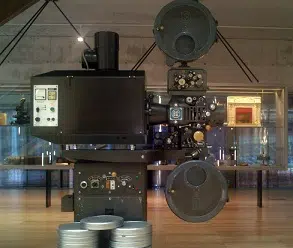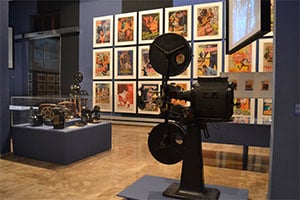 A film library is a space that stores films to exhibit them and to allow them to be studied . Sometimes the term refers specifically to the room where the screenings take place.
A film library is a space that stores films to exhibit them and to allow them to be studied . Sometimes the term refers specifically to the room where the screenings take place.
It should be remembered that a film is a movie : a tape with images that, when projected on a screen, generates the illusion of movement. By extension, the cinematographic work is called a film or movie.
It can be said that a film library, also called a cinematheque , is an archive that specializes in the conservation, restoration, cataloging and exhibition of cinematographic documents. Its collection, therefore, is made up of audiovisual materials and devices and machines linked to them.
It is important to mention that, in general, film libraries show films of cultural or educational interest . Unlike conventional movie theaters, they do not usually present premieres or films that aim only at entertainment.
Many times film libraries organize cycles to bring the work of great filmmakers to the public. In this way, different films by the same director are shown throughout different days.
The Spanish Film Archive , founded as the National Film Archive in 1953 , is an example of this type of institution. It is part of the orbit of the Institute of Cinematography and Audiovisual Arts ( ICAA ) of Spain and has its headquarters in Madrid .
In 1960 , meanwhile, the Film Library of the National Autonomous University of Mexico ( UNAM ) was born. Its purpose is to preserve and disseminate Mexican film memory .
Many film libraries are grouped together in the International Federation of Film Archives ( FIAF ), an entity created in 1938 . The base of this organization is located in Brussels , the capital of Belgium.
If we look for this term in the dictionary of the Royal Spanish Academy, we will also find a meaning whose use is relatively frequent in everyday speech: "collection or group of films." This strips away the meaning of a physical space in which to store or reproduce them, as it focuses solely on the items themselves, regardless of format.
 In everyday speech, depending on the region and the age of the speakers, it is possible to encounter this word or, more commonly, video library , film library or, although incorrect in this context, library . Yes, the latter is defined as "a collection or set of books", but it is not uncommon to see it in other areas, both to talk about movies and video games (in the latter case the correct thing would be to say toy library ).
In everyday speech, depending on the region and the age of the speakers, it is possible to encounter this word or, more commonly, video library , film library or, although incorrect in this context, library . Yes, the latter is defined as "a collection or set of books", but it is not uncommon to see it in other areas, both to talk about movies and video games (in the latter case the correct thing would be to say toy library ).
Since until the end of the 90s, films were distributed mainly in physical format, either on cassette or on disc, the vast majority of film lovers have a private collection on the shelves of their homes. However, the furor of online platforms that allow the rental or purchase of movies in digital format has led millions of people to opt for this method for reasons of convenience.
Image quality is one of the key factors when creating or maintaining a film library. In turn, this can be affected by the format: a cassette, for example, deteriorates with use and the passage of time since the reading is analog, while an optical disc (such as a Blu-ray or a DVD) It always offers the same image quality, because the information is stored digitally and there is no physical wear and tear when reading it.
In the case of streaming services, the aforementioned platforms that offer the rental or purchase of content over the Internet, there is no wear and tear either. However, if the quality of the playback depends on the connection, it is variable and can give noticeably different results from one session to another. Building a film library with remote or tape content , therefore, are the two least recommended options.
